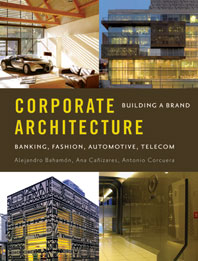BMW Welt restaurants
FG Stijl creates coziness for the dining spaces of BMW Welt.
Architects & Firms
Munich, Germany
At 753,473 square feet, the Coop Himmelb(l)au–designed BMW Welt in Munich can easily accommodate the showroom, retail, and branding functions worthy of its “Car-thedral” nickname. To punctuate the vastness of stainless steel, glass, and concrete, the 12-year-old Amsterdam firm FG Stijl was hired to create four restaurants that would be inviting and comfortable spaces—oases of compassion in this world of machines.
“The whole story of BMW Welt is about creating intimacy in this enormous space,” says Colin Finnegan, who cofounded FG Stijl with Gerard Glintmeijer in 1995. Lighting would be the protagonist. Finnegan points out that the cavernous ceiling heights forbade pendants, so, he says, “The warmth of the interiors and furniture was going to have to come from the furniture itself.” Indeed, a focal point of FG Stijl’s intervention is a series of internally illuminated furniture pieces that, alongside stainless-steel trim and leather upholstery borrowed directly from car passenger cabins, unify the four restaurants.
Coop Himmelb(l)au’s architecture easily dictated the placement of dining rooms. “The building was created with chasms and caves, and I saw these hollowed-out areas as natural environments,” Finnegan says. FG Stijl tucked display fixtures, bars, and open kitchens into the otherwise open spaces.
The ground-floor Bistro announces its budget fare as visitors proceed from the entryway. On a recent Saturday, it was filled with families who had come to peruse the motorcycles and hit up the gift shop. Happy shoppers’ glow didn’t necessarily come from within. Rather, dining tables in creamy glass and stainless steel were also conceived as light boxes, fitted with fluorescent lamps that cast a warm but clear light.
A prominently placed stairway entices visitors to the second level, where the Café and an adjacent bookstore are not as assertively positioned as the Bistro below. “We wanted the restaurant spaces to be easy,” Finnegan says of the way traffic flow ostensibly skirts each dining area. “The idea was to offer options, never to pin the visitor into a corner.” The Café also features oversize light-box tables, in particular an illuminated central area and surrounding tables that can be reconfigured for after-hours use as a bar.
Both the Café and International Restaurant (so named for its sushi-to-schnitzel menu) share a 130-seat terrace overlooking Munich’s Olympic Park. In this outdoor space, FG Stijl complements Coop Himmelb(l)au’s moves. Furniture is covered in a Kvadrat fabric with metallic sheen that echoes the architect’s material palette, and retractable sail-like shades echo the building geometry. Here, the light boxes reappear, this time in the form of several host podiums whose low color temperature matches the halogen lighting in the sails. Inside the International Restaurant, stainless-steel walls appear plucked from the architecture, and dining tables that convert from dining to lounge height evoke the dynamism of a soft top.
The fourth restaurant, the 50-seat Club Restaurant, is one component of the third-story Club Floor and offers a commanding view of BMW Welt’s interior. “We wanted people to feel special in this place,” Finnegan says. “It reflects BMW—there is a range of product, and the Club represents that exclusive option.”
Although light boxes are deployed as an entrance bar and as surrounds for the open kitchen and a creamy sofa, the Club Floor is a drastic departure. Illumination levels are more subdued, courtesy of mushroomlike pleated fabric lamps, and rooms feature multiple layers of materials and amenities, such as a 16-foot, backlit wine wall in the lounge that precedes the Club Restaurant dining room.
In the milieu of the Club Floor, one decision encapsulates the challenge FG Stijl faced throughout the entire project: A rear wall of the Club Restaurant’s lounge is clad in rain-forest brown marble that is scrubbed with steel brushes to create a tactile effect. “We had three walls of glass looking over a stainless interior, and we needed a backdrop,” says Finnegan. Like its other humanizing gestures at BMW Welt, FG Stijl’s earthy marble, paired with the dark walnut floors, effects a warm cliffside aerie for peering into the sea of steel, glass, and concrete below.



